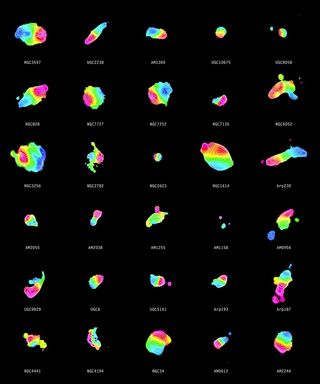Some Galaxies Like Our Milky Way are Born in Colossal Crashes

The history of the Milky Way has a new wrinkle.
Scientists used radio telescopes like the Atacama Large Millimeter/submillimeter Array — a vast array of receivers in Chile — used to probe galaxies within 40 million to 600 million light-years from Earth. After observing dozens of merging galaxies, astrophysics found that many galactic collisions will create disc galaxies similar to the Milky Way, a surprising finding.
Their observations of carbon monoxide in 37 colliding galaxies showed pancake-shaped zones of molecular gas, similar to the shape that disc galaxies — which include spiral galaxies and lenticular galaxies — would assume.
"This is a large and unexpected step towards understanding the mystery of the birth of disc galaxies," lead researcher on the study Junko Ueda, a postdoctoral fellow at the Japan Society for the Promotion of Science, said in a European Southern Observatory statement.
Before, astronomers thought that only elliptical galaxies could arise from mergers. Simulations from the 1970s, however, concluded that elliptical galaxies should be the most popular type of galaxy in the universe. Yet these odd-shaped entities comprise less than 30 percent of galaxies. The new study could help explain why scientists see so many spiral galaxies like the Milky Way in the universe, according to ESO.
The astronomers' work is the biggest molecular gas study so far, but they said they plan more work to follow up on their research. Astronomers emphasized more observations of older galaxies are required to see if mergers behaved similarly in the young universe.
"We have to start focusing on the formation of stars in these gas discs. Furthermore, we need to look farther out in the more distant universe," Ueda said. "We know that the majority of galaxies in the more distant universe also have discs. We, however do not yet know whether galaxy mergers are also responsible for these, or whether they are formed by cold gas gradually falling into the galaxy. Maybe we have found a general mechanism that applies throughout the history of the universe."
Get the Space.com Newsletter
Breaking space news, the latest updates on rocket launches, skywatching events and more!
The research was published in the Astrophysical Journal Supplement.
Follow Elizabeth Howell @howellspace. Follow us @Spacedotcom, Facebook and Google+. Original article on Space.com.
Join our Space Forums to keep talking space on the latest missions, night sky and more! And if you have a news tip, correction or comment, let us know at: community@space.com.

Elizabeth Howell (she/her), Ph.D., is a staff writer in the spaceflight channel since 2022 covering diversity, education and gaming as well. She was contributing writer for Space.com for 10 years before joining full-time. Elizabeth's reporting includes multiple exclusives with the White House and Office of the Vice-President of the United States, an exclusive conversation with aspiring space tourist (and NSYNC bassist) Lance Bass, speaking several times with the International Space Station, witnessing five human spaceflight launches on two continents, flying parabolic, working inside a spacesuit, and participating in a simulated Mars mission. Her latest book, "Why Am I Taller?", is co-written with astronaut Dave Williams. Elizabeth holds a Ph.D. and M.Sc. in Space Studies from the University of North Dakota, a Bachelor of Journalism from Canada's Carleton University and a Bachelor of History from Canada's Athabasca University. Elizabeth is also a post-secondary instructor in communications and science at several institutions since 2015; her experience includes developing and teaching an astronomy course at Canada's Algonquin College (with Indigenous content as well) to more than 1,000 students since 2020. Elizabeth first got interested in space after watching the movie Apollo 13 in 1996, and still wants to be an astronaut someday. Mastodon: https://qoto.org/@howellspace
Most Popular

